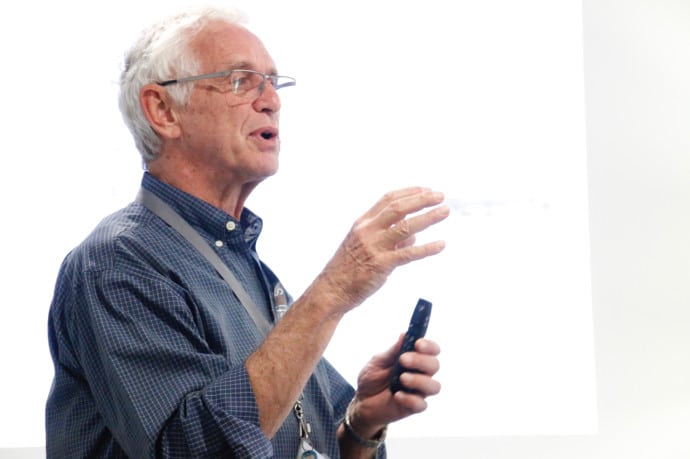“Though we all recognise the material world is made up of living and non-living forms, the logical connection between these forms remains a continuing scientific puzzle,” said Addy Pross, Emeritus Professor in the Department of Chemistry, Ben Gurion University, Israel and current STIAS fellow. “Living and non-living systems are strikingly different. Yet the established principles of physics and chemistry seem unable to clarify that difference and a wide conceptual gulf continues to separate animate and inanimate. Science continues to struggle with two tantalising central questions regarding living systems: how was life able to emerge from non-life, and how can the evolutionary process be understood in more general physical/chemical terms?”

“The mother of all chemical problems is biology,” he added. “The big questions in chemistry are the relationship between living and non-living matter and the origins of life. How could ‘dead stuff’ become ‘living stuff’? The emergence of life has long been a deep physical puzzle.”
Pross was presenting his latest work at a STIAS fellows’ seminar.
A new area of chemistry, systems chemistry, attempts to connect these two distinct worlds.
“Systems chemistry was a term coined in 2006 – it deals with simple-replicating chemical systems and the networks they establish,” he continued. “Replication is a very specific reaction. Regular chemistry broadly deals with non-replicating systems, while biology is about complex-replicating systems. Systems chemistry, with its focus on simple-replication reactions serves as a bridge between the two.”
Pross pointed out that this emergent field has begun to make progress in understanding the gap between simple molecular replicating systems and highly complex replicating systems – life. Research involves elucidating the physical and chemical principles governing replicating molecules and the networks they establish. “Such study will hopefully help uncover the chemical roots of Darwinism and better connect the physical and biological sciences.”
“It’s about extending Darwin from biology back into chemistry.”
“According to the Second Law of Thermodynamics, matter is transformed from less to more stable states, from low- to high-probability states. The emergence of life is in some sense counter-thermodynamic – seemingly going in the wrong direction, toward less stable and highly complex, low-probability systems.”
It seems, however, that the concept of stability may be more complicated than previously thought. “We have demonstrated that there are two distinct kinds of stability in nature – thermodynamic stability associated with ‘regular’ chemical systems, and dynamic kinetic stability (DKS), associated with replicating systems. A deeper understanding of the stability conceptmay help uncover the physicochemical principles responsible for the emergence of life and the relationship between emergence and evolution, allowing the Second Law of Thermodynamics and Darwin’s theory of evolution to be reconciled.”
“DKS works on the idea of a replicating system being stable if the rate of replication formation is balanced by the rate of replication decay. The replicating population thus remains stable though not the individual replicating entities, which form and then decay. So matter may be stable, not just in energy terms, but in the sense of being persistent through self-replication. Importantly the DKS concept applies equally to chemical and biological systems.”
“Replication leads to variation (as mutant versions appear),” added Pross “and this leads to selection (the mutants compete with the originals with the faster ones out-replicating the slower ones leading to their extinction) and hence evolution.”
Thermodynamic and dynamic kinetic stabilities are therefore distinct with change in these two stabilities governed by different measures of progress, though ultimately governed by the same basic principle – the drive toward more persistent forms.
“Accordingly such a replicative process can direct non-life toward simple life and then on to more complex life.”
“So the division into so-called chemical and biological phases in the emergence of life is artificial. Biology and chemistry are intimately connected. In fact, biology started with chemistry. The process by which life emerged from inanimate matter and that of biological evolution are one continuous process with a common, identifiable driving force.”
“Hence what we are proposing is that change (evolution in its most general sense) can take place in both worlds, both ‘regular’ and replicative, so that there are two evolutionary pathways. The regular world moves towards increasing entropy while the replicating world (governed by DKS) moves towards increasing complexity. Two distinct processes, but one basic principle – toward increasing persistence.”
Pross sees biology as ‘complex-replicating chemistry’ and believes that Darwin’s concepts of natural selection, fitness, survival of the fittest and co-operation are expressions of more basic chemical concepts.
“The two pillars of evolution – competition and co-operation – have kinetics and network selection as underlying processes,” he continued.
I’ll scratch your back if you scratch mine
And it’s a process where co-operation and networking are positives. “Two is almost always better than one – a network of replicating molecules leads to faster replication and continuous exponential growth,” said Pross. “Network formation makes replication more effective.”
“Co-operation equals complexification,” he added “which enhances the replication function at chemical and biological levels.”
But complexity is multi-level and dynamic. “Improved function requires greater complexity until you reach an optimum level of complexity at which point there can be a levelling off. Once you get to optimum complexity, things will stay much the same.”
“Unchanging things don’t change, and changing things do change, until they change into things that don’t …”
“The energy sources may be different – for example, solar energy or chemical energy – but all energy sources that drive replicating systems function by increasing complexity,” he continued.
“Our take-home message is that life (from a chemical perspective) is just an energy-fuelled highly complex chemical-replicating network.”
“We believe that DKS could allow a resolution of many of life’s key paradoxes,” he concluded. “The diverse characteristics of the DKS space explain both life’s unique characteristics and its extraordinary diversity.”
Michelle Galloway: Part-time media officer at STIAS
Photograph: Christoff Pauw
